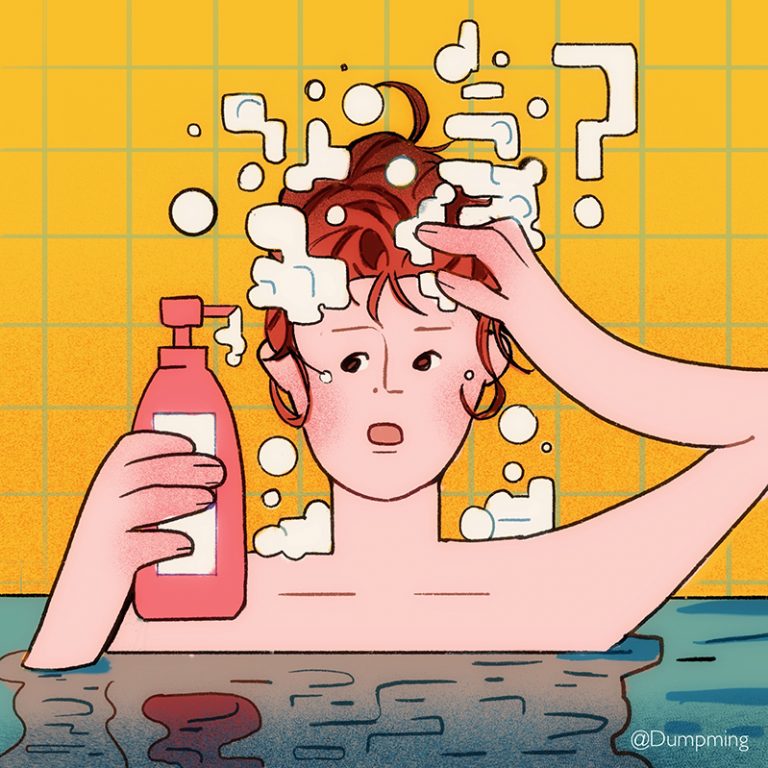
Written by Shanzeh Ahmed
Illustrated by Jenny Zhang
A tale as old as time, or, at least, a fairly common occurrence in our day-to-day lives: it’s a Sunday night and you’re getting ready for the start of a new week. As you look at yourself in the mirror, you realize your hair is a bit greasy and make a mental note to wash it tonight. You take out your favourite shampoo and put on some shower tunes!
But have you ever thought about what makes your hair greasy anyway? And how does shampooing even help? Well, your skin and scalp have sebaceous glands, which produce a greasy substance called sebum, mainly to protect hair follicles and give your hair a natural shine. However, too much sebum will make your hair look clumpy and allow dirt and various external particles to stick to its surface. Sebum is also hydrophobic, meaning it interacts with other oils and repels water.
To help remove sebum, shampoos contain surfactants, or molecules that are both hydrophobic and hydrophilic, meaning they can interact with oil and water alike. The hydrophobic portion interacts with the sebum and the hydrophilic interacts with water, allowing us to wash off the oils from our hair. However, as mentioned before, these oils can actually be somewhat protective of hair follicles and provide a certain sheen to hair. Excessive shampooing can thus leave hair dry and dull. This is where conditioners come in! Many surfactants, like sulfates, are negatively charged. Therefore, many conditioners will have positively charged molecules, allowing them to coat the hair, replenish moisture and detangle knots.
Your shampoo bottle doesn’t just contain molecules that help clean and re-moisturize hair though. It also includes other additives that can make your hair look more aesthetically pleasing. For instance, protectant chemicals can help prevent sun damage, colour loss for dyed hair or chemical damage from pools. There are also cosmetic molecules that add scent or glimmer to your hair. Then there are the more functional ingredients, which provide stability and shelf-life to these mixtures. Fun fact: the foaminess of shampoo does not significantly aid its ability to clean. It’s mostly there for consumers to enjoy the process more!
Another problem that shampoo can help with is dandruff! Dandruff appears due to a scalp-specific fungus called Malassezia. The fungus feeds on sebum on the scalp and forms a lipid or fat-based by-product called oleic acid. This substance can penetrate the top layer of the scalp and initiate an inflammatory reaction, resulting in dandruff. Some shampoos are even made specifically to help get rid of dandruff! Anti-dandruff shampoos contain all the same cleaning molecules as regular shampoos, with the addition of active anti-fungal molecules such as salicylic acid or zinc pyrithione.
Like most things in life, making shampoo is a balancing act. Manufacturers want to optimize shampoo composition by maximizing its ability to clean your scalp while minimizing any resulting dryness or hair damage. Next time you’re in the shower, you can take a look at the list of ingredients on your shampoo bottle. Now you’ll know what all those funny-sounding chemicals are actually doing!
Sources:
- https://www.sciencedirect.com/topics/chemistry/shampoo
- https://bcachemistry.wordpress.com/2013/11/02/shampoo-chemistry/
- https://www.thoughtco.com/how-shampoo-works-607853
- D’Souza, Paschal, and Sanjay K Rathi. “Shampoo and Conditioners: What a Dermatologist Should Know?.” Indian journal of dermatology vol. 60,3 (2015): 248-54. doi:10.4103/0019-5154.156355